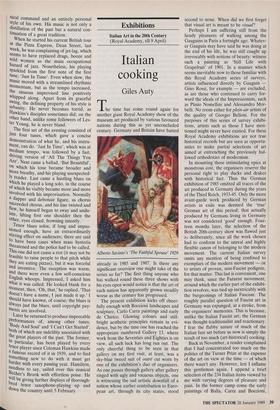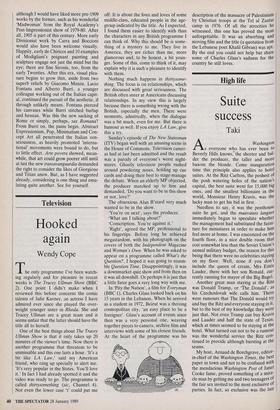Exhibitions
Italian Art in the 20th Century (Royal Academy, till 9 April)
Italian cooking
Giles Auty
The time has come round again for another giant Royal Academy show of the museum art produced by various favoured nations during this as yet unconcluded century. Germany and Britain have batted
Alberto Savinio's 'The Faithful Spouse' 1929 already in 1985 and 1987. Is there any significant overview one might take of the series so far? The first thing anyone who has walked round these three shows with his eyes open would notice is that the art of each nation has apparently grown steadily worse as the century has progressed.
The present exhibition kicks off cheer- fully enough with Boccioni landscapes and sculpture, Carlo Carra paintings and early de Chirico. Glowing colours and still- bright aesthetic principles remain in evi- dence, but by the time one has reached the appropriate numbered Gallery 13, where work from the Seventies and Eighties is on view, all such luck has long run out. The only cheerful thing to be seen in that gallery on my first visit, at least, was a sky-blue tweed suit of outré cut worn by one of the exhibition's duo of organisers. As one passes through gallery after gallery ringed with ugly and vacuous objects, one is witnessing the sad artistic downfall of a nation whose earlier contribution to Euro- pean art, through its city states, stood second to none. When did we first forget that visual art is meant to be visual?
Perhaps I am suffering still from the heady pleasures of walking among the Gauguins in Paris a fortnight ago. Whatev- er Gauguin may have said he was doing at the end of his life, he was still caught up irrevocably with notions of beauty: witness such a painting as 'Still Life with Grapefruit' of 1901. In a manner which seems inevitable now to those familiar with this Royal Academy series of surveys, artists influenced directly by Gauguin Gino Rossi, for example — are excluded, as are those who continued to carry for- ward the ideals of the Impressionists, such as Plinio Nomellini and Alessandro Mor- belli. No room either for plein-air artists of the quality of Giorgio Belloni. For the purposes of this series of survey exhibi- tions, artists such as those I have men- tioned might never have existed. For these Royal Academy exhibitions are not true historical records but are seen as opportu- nities to make partial selections of art aimed at entrenching the previously hal- lowed orthodoxies of modernism.
In mounting these intimidating epics at monstrous cost, the organisers reserve the personal right to play ducks and drakes with historical fact. Thus the German exhibition of 1985 omitted all traces of the art produced in Germany during the years of the Third Reich, 1933-45. Only the more avant-garde work produced by German artists in exile was deemed the 'true' German art of this period; that actually produced by Germans living in Germany was not considered 'good' enough. Four- teen months later, the selection of the British 20th-century show was flawed just 23 deliberately, since all the work chosen had to conform to the unreal and highly flexible canon of belonging to the modern movement. The current Italian survey omits any mention of being confined to exemplars of the modern movement — or to artists of proven, non-Fascist pedigree, for that matter. This last is convenient, one may think, since the Futurist movement, around which the earlier part of the exhibi- tion revolves, was tied up inextricably with the burgeonings of Italian Fascism. The roughly parallel question of Fascist art in Germany was expunged, at a stroke, from the organisers' memories. This is because, unlike the Italian Fascist art, the German was thought traditionalist and reactionary. I fear the flabby nature of much of the Italian fare set before us now is simply the result of too much (art-historical) cooking.
Back in November, a reader complained that I had concentrated too much on the politics of the Turner Prize at the expense of the art on view at the time — of which there wasn't any. However, lest I inflame this gentleman again, I append a brief selection of the 234 Italian items viewed by me with varying degrees of pleasure and pain. In the former camp come the early paintings of Balla, Carra and Boccioni, although I would have liked more pre-1909 works by the former, such as his wonderful `Madwoman' from the Royal Academy's Post-Impressionist show of 1979-80. After all, 1905 is part of this century. More early Divisionist work by Carra and Boccioni would also have been welcome visually. Happily, early de Chiricos and 10 examples of Modigliani's poignant painting and sculpture engage not just the mind but the eye; there are fine Sironis, too, from the early Twenties. After this era, visual plea- sure begins to grow thin, aside from two superb reliefs by Giacomo Manzu. Lucio Fontana and Alberto Burri, a younger colleague working out of the Italian capit- al, continued the pursuit of the aesthetic, if through unlikely means. Fontana pierced his canvases while Burri stitched burlap and hessian. Was this the new sacking of Rome or simply, perhaps, sax Romana? From Burri on, the pains begin. Abstract Expressionism, Pop, Minimalism and Con- cept Art all penetrated the Italian con- sciousness, as heavily promoted 'interna- tional' movements were bound to do, but to little effect. Arte povera showed, mean- while, that art could grow poorer still until at last the new transavanguardia demanded the right to consider the likes of Giorgione and Titian anew. But, as I have suggested already, considering is one thing and emu- lating quite another. See for yourself.


















































 Previous page
Previous page